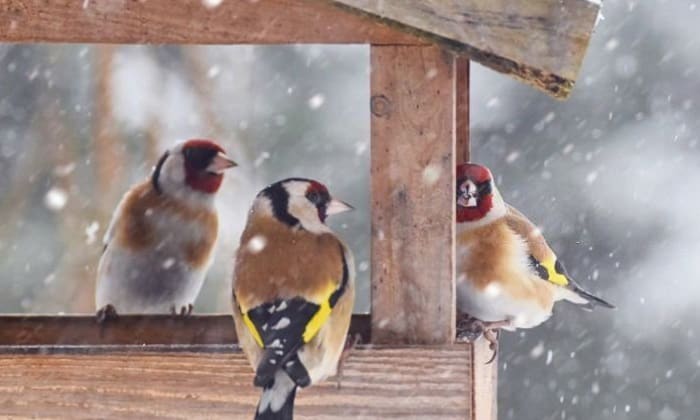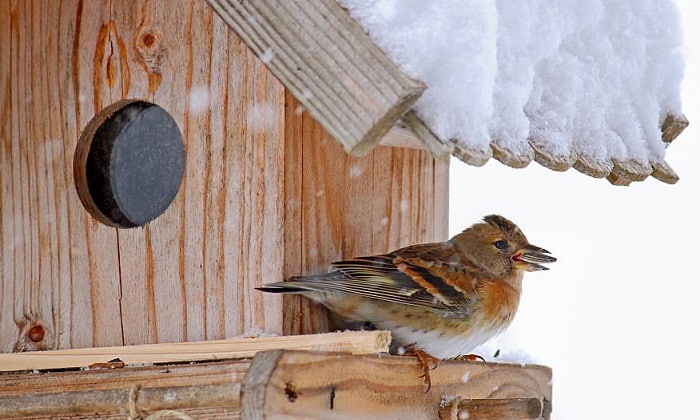Where do birds go when it snows? Many birds flee the snow and the cold by flying to the warmer south. Non-migratory birds, however, choose to stay and deal with the elements instead.
Birds in snow need shelter and protection from the wind and cold. They can hide in dense bushes, inside birdhouses or holes in trees, or even stay on the downwind side of a tree.
Table of Contents
Where Will Birds Go When It Snows?
Migratory birds go in the winter in search of warmer climates. They actually do so more in pursuit of their food than for their comfort – you can’t find too many insects in frozen soil under layers of snow. Without food, the avian won’t be able to survive the cold.
Each species has its own schedule, but birds usually move southward just as summer ends and throughout the fall.
They then return home in time for spring when fruit, flowers, and grub are aplenty. Typically, birds go at night for their return journey.
Non-migratory birds, on the other hand, have to get creative to survive the weather.
How Do Birds Survive a Snowstorm?
Being mostly airborne animals, birds are vulnerable when it storms. However, scientists have observed that birds are extremely sensitive to barometric pressure, or the amount of air pressure in the atmosphere.
The takeaway here is birds know when a storm is coming because of lower pressure and can take measures to prepare in advance.
Have you ever seen a bird seemingly stuffing itself senseless? This is because the species intentionally put on extra weight to get ready for food abstinence when it rains or snows.
Another interesting bird behavior before snow storms is the look of agitation and alertness. They may jump around spots they normally wouldn’t, seemingly unable to sit still.
However, the most important way birds protect themselves is by finding adequate shelter. Above all, their primary concern is not to get blown away and to stay warm.
Here are a few places birds go during snow storms:
1. Dense foliage like trees and bushes
Birds take refuge in thick bushes and leafy trees that can keep them safe from strong winds. For added protection, they stay on the downwind side of the tree and closer to the ground, where there might also be insects for food.
2. Inside tree holes and crevices
Some trees can offer safety for birds in their crevices or holes in their trunk made by woodpeckers or other birds.
3. Inside birdhouses
Birdhouses are much more than decorative – they can truly help smaller birds in storms!
4. Inside other structures
Birds sometimes hide behind or inside buildings and abandoned homes if nothing else is available.
It is not uncommon to find a wide variety of birds huddling together inside these structures during blizzards or even during hurricane to share warmth.
Since these areas generally guarantee protection, birds tend to use them all year round for various reasons.
Mothers tend to build their nests in these areas or high up in tree branches in the spring to help their baby birds survive storms and keep them hidden from predators.
Also, because of their seclusion, old birds go to die in them, too.
Related: Where do birds go during a hurricane or when it rains?
How Can You Help Overwintering Birds Survive Snowstorms?
Birds have three basic needs, particularly in the wintertime: food, water, and shelter. If you want to help overwintering birds or birds that live through winter, address these three.
1. Provide Food—The Fatter, The Better
Bodies require a lot of calories to keep warm, so birds are constantly looking to feed themselves throughout winter. The challenge is made even harder by reduced insect activity during this time.
It’s best to leave out food high in calories and fat for your visiting birds, such as oil, sunflower seeds, suet, and peanuts. Provide a generous amount so that if there are plenty of birds, they won’t have to compete for the food.
2. Provide Flowing Water
While leaving water out in your birdbath is helpful, remember this may freeze! If you can, it’s best to heat your birdbath to ensure the water stays melted. Make sure the avian can drink water without getting wet, which may result in frozen feathers.
3. Provide Shelter
You can build birdhouses or roosting boxes and leave them around your garden or prepare other, more natural shelters for birds in the winter.
These include your dead trees (don’t cut them down yet!), piles of dead leaves, and piles of rocks.
Read more about other methods to help birds in cold weather here!
Frequently Asked Questions
Can birds fly around in the snow?
Yes, birds fly in the winter and the snow, particularly since they do not hibernate and still need to look for food and water.
It is rarer to see a bird flying during a blizzard, but desperate ones risk it sometimes. Some birds that can fly in storms include crossbills, snowy owls, snow buntings, and Northern goshawks.
It’s not uncommon to see birds die in storms. However, the main reason is not that they get blown away, but because their food sources perish, leaving them starving.
Why do birds need to fly when it snows?
Birds go during a storm for three main reasons: food, water, and shelter.
mselves and stay hydrated throughout the cold months. Sometimes, their thirst or hunger doesn’t allow them to wait out the storm.
If the avian’s current shelter is also inadequate, they may go out hoping to find a more comfortable and protected place, somewhere closer to food or water, or all of the above.
Non-migratory birds such as pigeons, sparrows, and cardinals stay because they have developed ways to survive and prepare for the cold.
How do birds stay warm during winter?
Birds live in the winter while doing the following things to keep themselves safe:
- Gain weight: Birds eat a lot in the fall to prepare for the winter!
- Store food: Birds know less food is available in the cold months. They build many food stores in advance in many places.
- Grow more feathers: Beginning in the late autumn, many birds begin growing extra feathers.
- Fluff up their feathers: Fluffing feathers allow birds to trap air between their skin and feathers which helps them stay warmer.
- Fold up their legs: Now and then, birds stand on one leg to warm the other one under their feathers.
- Shiver: Shivering is the result of muscles tightening and loosening very rapidly. The expended energy produces warmth.
- Sunbathe: As much as they can, birds stay out to warm themselves in the sun’s bright rays
For more on this topic, click here!
Conclusion
For the most part, birds can take care of themselves. Nature and evolution prepared them well for the elements, after all.
Where do birds go when it snows? Some fly south towards warmth, while some look for sheltered areas that can protect them from strong winds.
However, a little help always goes a long way for all living creatures. If you are up to helping birds get through the winter just a bit more comfortably, they would greatly appreciate any food, water, or shelter you are willing to share with them.

George and I became friends after a birdwatching trip with our new group. And we have been enjoying every adventure together. When he told me the idea of establishing a site that shares our experiences and fun, I immediately agreed. After trials and errors, here we have Thayerbirding.















